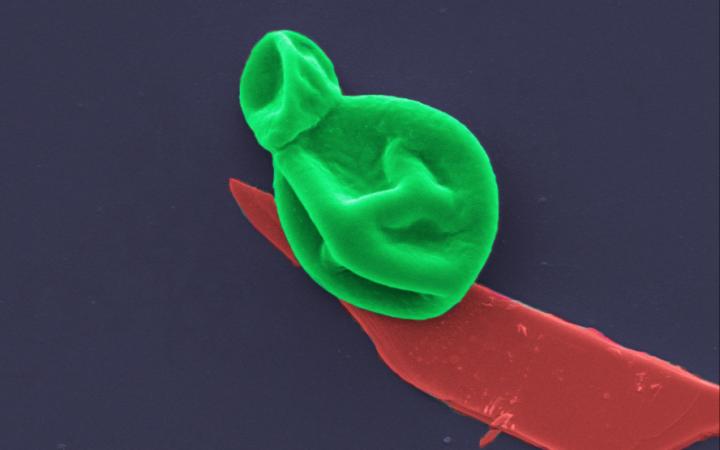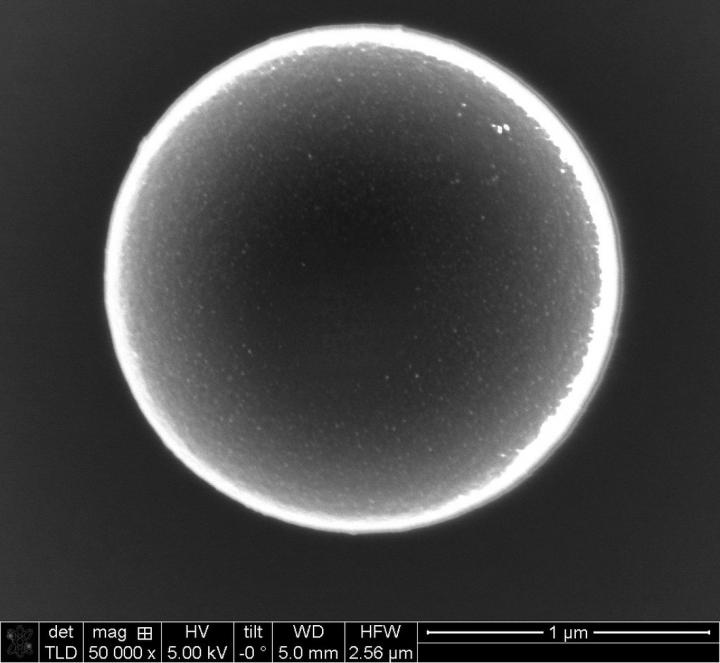New technology could steer plastics from landfills, oceans — and into your backyard compost bin
Tag: NANOTECHNOLOGY/MICROMACHINES
The CNRS 2021 Innovation Medal laureates
Antoine Aiello, Nora Dempsey, François Jérôme and Amanda Silva Brun are the four recipients of the CNRS 2021 Innovation Medal. Created 10 years ago, this distinction honours people whose outstanding research has led to significant technological, economic, therapeutic or social…
Dutch researchers establish the first entanglement-based quantum network
A team of researchers from QuTech in the Netherlands reports realization of the first multi-node quantum network, connecting three quantum processors. In addition, they achieved a proof-of-principle demonstration of key quantum network protocols. Their findings mark an important milestone towards…

Superbug killer: New nanotech destroys bacteria and fungal cells
Researchers have developed a new superbug-destroying coating that could be used on wound dressings and implants to prevent and treat potentially deadly bacterial and fungal infections.
Unlocking richer intracellular recordings
CMU/ITT researchers develop novel microelectrode platform to access and record intracellular activity
Lighting the way to folding next-level origami
Recent findings by Slovenian and German scientists artfully explore potential to transform proteins into custom-made structures
Visionary bone damage study
X-rays confirm promise of new luminescent markers
Designing selective membranes for batteries using a drug discovery toolbox
By binding specific ions in specially designed cages within its pores, a new membrane could enable more efficient flows in energy storage devices
A new, positive approach could be the key to next-generation, transparent electronics
Filling a crucial gap in the materials spectrum
This hydrogen fuel machine could be the ultimate guide to self-improvement
Study co-led by Berkeley Lab uncovers secret behind humble material’s surprise performance as an artificial photosynthesis device
Less than a nanometer thick, stronger and more versatile than steel
Scientists create stable nanosheets containing boron and hydrogen atoms with potential applications in nanoelectronics and quantum information technology. What’s thinner than thin? One answer is two-dimensional materials — exotic materials of science with length and width but only one or…
Titanium dioxide stars in the first IFJ PAN research at the Cracow synchrotron
Few compounds are as important to industry and medicine today as titanium dioxide. Despite the variety and popularity of its applications, many issues related to the surface structure of materials made of this compound and the processes taking place therein…
cientists observe role of cavitation in glass fracturing
Glassy materials play an integral role in the modern world, but inherent brittleness has long been the Achilles’ heel that severely limits their usefulness. Due to the disordered amorphous structure of glassy materials, many mysteries remain. These include the fracture…
3D design leads to first stable and strong self-assembling 1D nanographene wires
Nanographene is flexible, yet stronger than steel. With unique physical and electronic properties, the material consists of carbon molecules only one atom thick arranged in a honeycomb shape. Still early in technological development, current fabrication methods require the addition of…
Researchers develop third and final ‘made-to-order’ nanotube synthesis technique
The current method of manufacturing carbon nanotubes–in essence rolled up sheets of graphene–is unable to allow complete control over their diameter, length and type. This problem has recently been solved for two of the three different types of nanotubes, but…
Cohesive circuit protection for wearable electronics
Researchers from Osaka University developed a cellulose nanofiber coating that counters bending damage, retains electrode function underwater, and thus offers unparalled water resistance for flexible electronic devices
Smart glass has a bright future
Light modulation via optical MEMS microshutter and micromirror arrays could provide huge energy savings
A successful phonon calculation within the Quantum Monte Carlo framework
Scientists expand the scope of the quantum Monte Carlo framework by reducing the error in calculation of atomic forces in solids
‘Designer’ pore shows selective traffic to and from the cell nucleus
The nucleus is the headquarters of a cell and molecules constantly move across the nuclear membrane through pores. The transport of these molecules is both selective and fast; some 1,000 molecules per second can move in or out. Scientists from…
A Skoltech method helps model the behavior of 2D materials under pressure
Scientists from the Skoltech Center for Energy Science and Technology (CEST) have developed a method for modeling the behavior of 2D materials under pressure. The research will help create pressure sensors based on silicene or other 2D materials. The paper…
Century-old problem solved with first-ever 3D atomic imaging of an amorphous solid
UCLA-led study captures the structure of metallic glass
Why are optical refractive indices so small?
Pink Floyd’s Dark Side of the Moon cover, voted the greatest classical rock album of all time, intended to portray the prism and dispersion of light into a rainbow as a certain metaphorical symbolism and a light show that was…
Faraday Institution commits a further £22.6m to battery research to deliver commercial impact
Integrated project on battery safety formed
UMass Amherst food scientist honored with top awards
Eric Decker, professor of food science, has recently received the two top awards in his field – the American Oil Chemists’ Society’s (AOCS) Supelco/Nicholas Pelick Research Award and the Institute of Food Technologist’s (IFT) Lifetime Achievement Award in Honor of…
First steps towards revolutionary ULTRARAM™ memory chips
A new type of universal computer memory – ULTRARAM™ – has taken a step closer towards development with a successful experiment by Lancaster physicists. Professor Manus Hayne, who is leading the research, commented: “These new results confirm the astonishing properties…
Scientists use nanotechnology to detect bone-healing stem cells
Researchers at the University of Southampton have developed a new way of using nanomaterials to identify and enrich skeletal stem cells – a discovery which could eventually lead to new treatments for major bone fractures and the repair of lost…
Method offers inexpensive imaging at the scale of virus particles
Using an ordinary light microscope, researchers can now obtain images with unprecedented accuracy
Tires turned into graphene that makes stronger concrete
Rice University lab’s optimized flash process could reduce carbon emissions
The Protein Society announces its 2021 award recipients
The Protein Society, the premier international society dedicated to supporting protein research, announces the winners of the 2021 Protein Society Awards, which will be conferred at the 35th Anniversary Symposium (virtual), July 7 – 14, 2021. Plenary talks from award…
Contact lenses poised to detect cancer, treat disease and replace digital screens
Newly-published “contact lens technologies of the future” paper reviews innovative uses for disease detection and therapy, drug delivery, vision enhancement and mor
Electromagnetic fields of nanostructures visualized in 3D for the first time
Scientists from Graz, Austria, succeeded for the first time in visualizing temporal distortions of the atomic lattice on the surface of materials in three dimensions.
Faster and less-invasive atomic force microscopy for visualizing biomolecular systems
High-speed atomic force microscopy (HS-AFM) is an imaging technique that can be used for visualizing biological processes, for example the activity of proteins. Nowadays, typical HS-AFM frame rates are as high as 12 frames per second. In order to improve…
Contemplate the nature of robotics at EPFL Pavilions
At the entrance of Nature of Robotics a couple of robotic snails slither around the floor, leaving behind slimy trails. Two visitors, young boys, enter the exhibit and squat next to the slimy creatures, trying to follow both of them…
Sorting out nanodiamonds with fluorescent centers
Scientists have developed a method to use lasers to control the movement of nanodiamonds with fluorescent centers. Scientists have long been working on improving their ability to use lasers to move small objects without actually touching them. This method of…
DNA–Metal double helix
Single-stranded DNA as supramolecular template for highly organized palladium nanowires
Controlling bubble formation on electrodes
Study finds the wettability of porous electrode surfaces is key to making efficient water-splitting or carbon-capturing systems

How tiny machines become capable of learning
Microswimmers are artificial, self-propelled, microscopic particles.
Gearing up nanoscale machines
Researchers at Nara Institute of Science and Technology, Japan, in partnership with research teams at University Paul Sabatier, France, are advancing the science of molecular-scale gear trains for transmitting rotational force
TPU scientists develop sensor with nanopores for definition doping in blood
Scientists of Tomsk Polytechnic University jointly with colleagues from different countries have developed a new sensor with two layers of nanopores. In the conducted experiments, this sensor showed its efficiency as a sensor for one of the doping substances from…
How tiny machines become capable of learning
Team of physicists led by Professor Frank Cichos develop learning microswimmers
New UCF nanotech gives boost to detection of cancer and disease
The technique uses nickel-platinum nanoparticles to increase the sensitivity of an ELISA, which is used to test for the presence of cancers, HIV and more.
Exploring the nanoworld in 3D
On the nanometric scale (one billionth of a metre), materials can feature new properties. A French team together with an Austrian one recently took an important step forward by mapping one of these properties for the first time in 3D.…
New nanotransistors keep their cool at high voltages
Power converters are the little-known systems that make electricity so magical. They are what allow us to plug in our computers, lamps and televisions and turn them on in a snap. Converters transform the alternating current (AC) that comes out…
Design could enable longer lasting, more powerful lithium batteries
Use of a novel electrolyte could allow advanced metal electrodes and higher voltages, boosting capacity and cycle life.
Revealing nano big bang — Scientists observe the first milliseconds of crystal formation
New study shows how stable materials have unstable beginnings
The world’s longest bottlebrush polymer ever synthesized
Potential utility for the development of flexible, low-friction polymeric materials
Researchers discover new organic conductor
Salts are far more complicated than the food seasoning – they can even act as electrical conductors, shuttling current through systems. Extremely well studied and understood, the electrical properties of salts were first theorized in 1834. Now, nearly 200 years…
New automated process makes nanofiber fabrication assessment 30% more accurate
Imbued with special electric, mechanical and other physical properties due to their tiny size, nanofibers are considered leading-edge technology in biomedical engineering, clean energy and water quality control, among others. Now, researchers in Italy and UK have developed an automatic…
E. Coli calculus: Bacteria find the derivative optimally
Tokyo, Japan – Scientists from the Graduate School of Information Science and Technology at The University of Tokyo calculated the efficiency of the sensory network that bacteria use to move towards food and found it to be optimal from an…
Electrochemical synthesis of formate from CO2 using a Sn/reduced graphene oxide catalyst
[Background] Decreasing the emission and efficient utilization (fixation) of carbon dioxide (CO 2 ) are worldwide issues to prevent global warming. Promotion of the use of renewable energy is effective in reducing CO 2 emissions. However, since there are large…